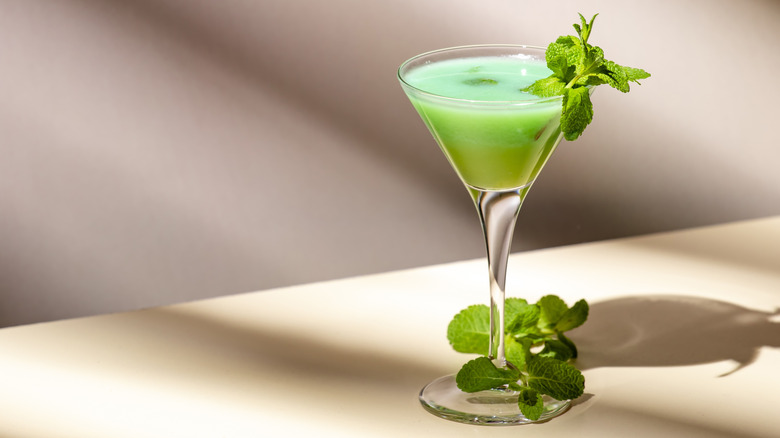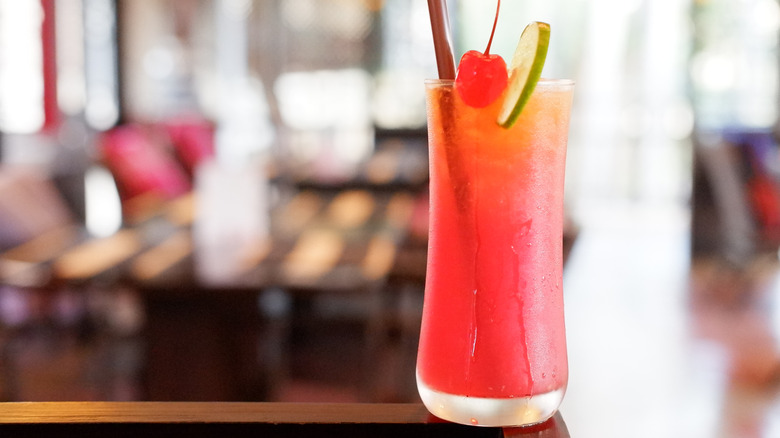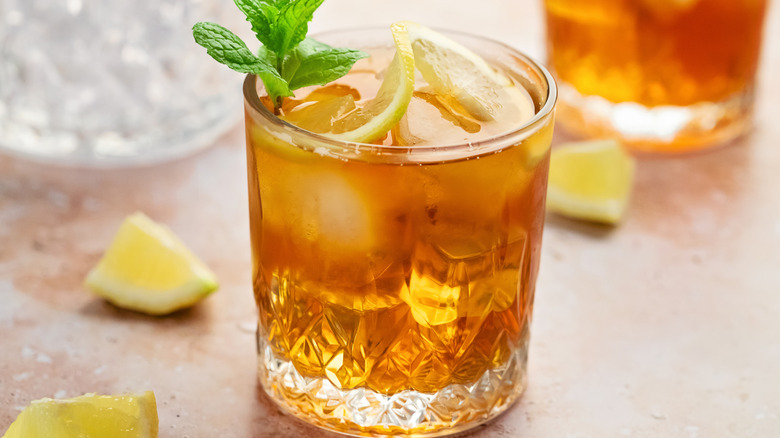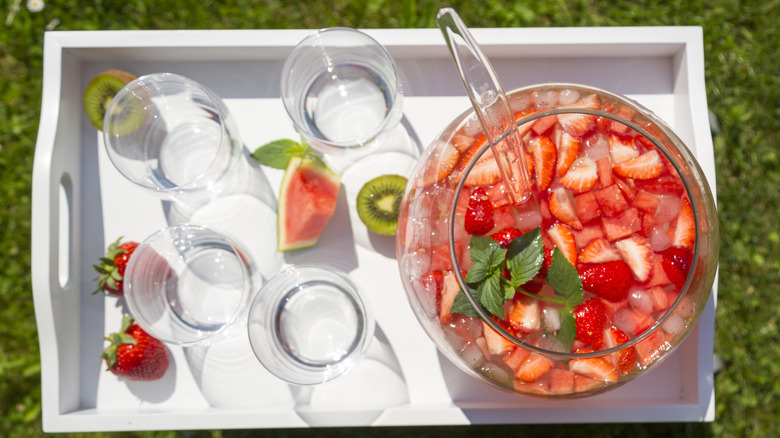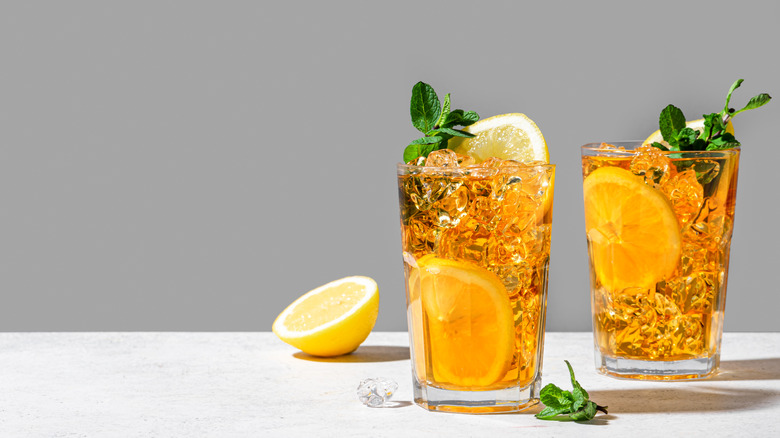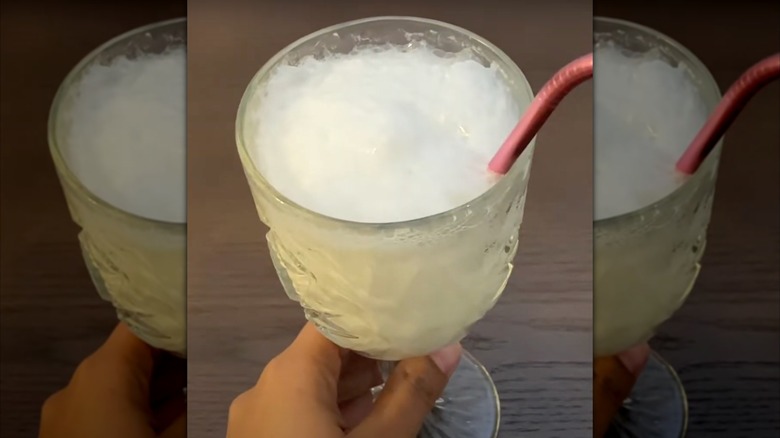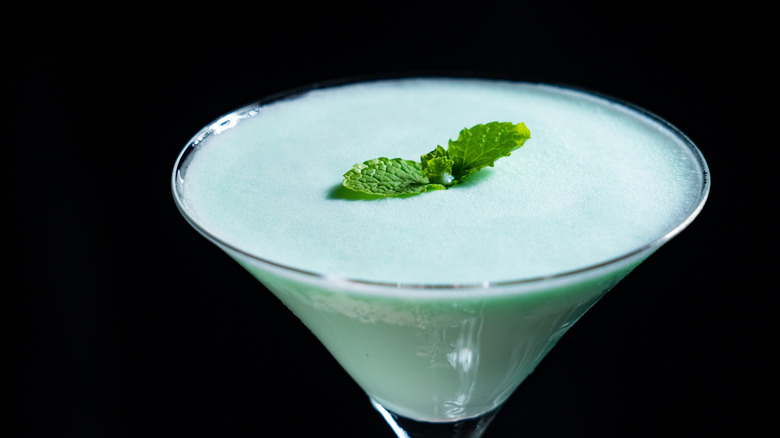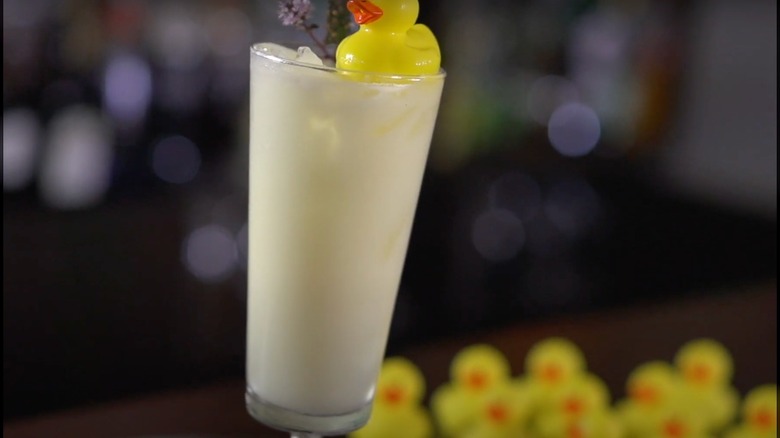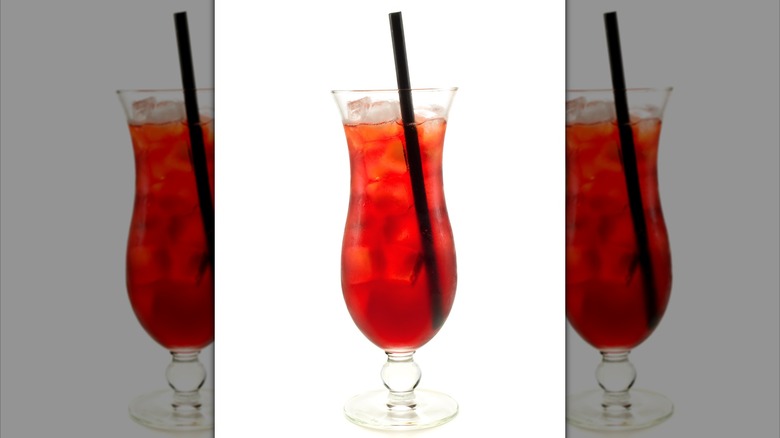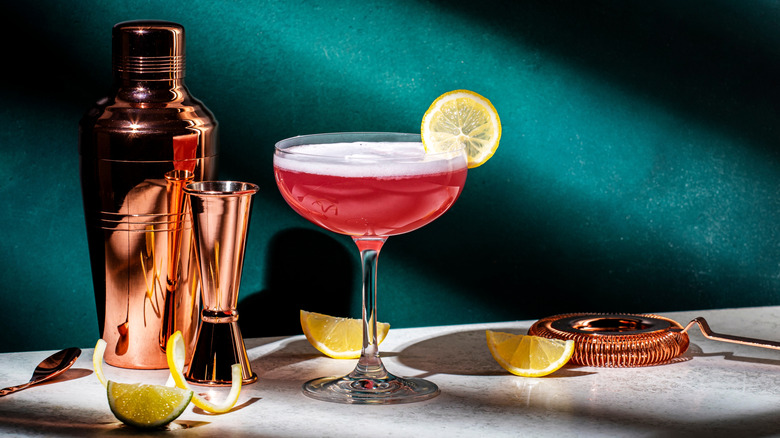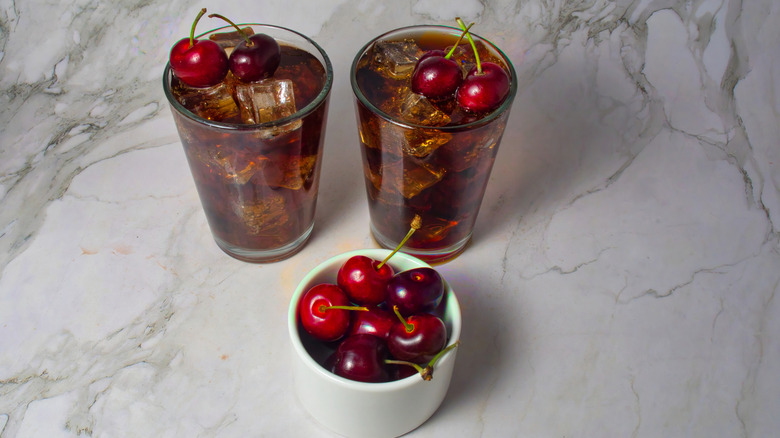10 Retro Drinks Your Grandma Used To Make
Grab a glass and kick back, because we're about to pour out a chilled glass of nostalgia for you. Like any recipe, drinks recipes come and go, and what your grandma used to make on the regular may seem completely retro nowadays. The kinds of drinks that you might have been served when you went to her house, be they nonalcoholic or full of booze, often felt like they were from another era — because they were.
However, it's undeniable that retro drinks were way more exciting than they are nowadays. You just have to look at a Grasshopper or a 7-Up Float, in all of their colorful glory, to know that we've lost a bit of pizzazz when it comes to our liquid accompaniments. Just like those vintage no-bake desserts grandma used to prepare, vintage drinks often put appearance first, and served as little art pieces that happened to taste really good. You might not remember some of these, but we can guarantee you that you'll be making some of them at your next cocktail party.
Shirley Temple
One of the most famous mocktails out there is also one of the most retro. The Shirley Temple got its name from the child star, who was apparently served it when dining with her parents. Temple's mom and dad were drinking Old Fashioneds, and she felt left out of cocktail hour. In response, the bar staff in the restaurant she was dining in made an alcohol-free alternative that was garnished with a classic maraschino cherry, and a classic was born.
Interestingly, Temple herself actually wasn't a fan of the drink, finding it to be too sweet. That didn't stop it taking off, though, with its popularity culminating in Temple suing a company who tried to sell a bottled version of the cocktail in 1988 under her name without permission. Before that lawsuit even occurred, though, the combination of ginger ale, grenadine, and a cherry became highly popular with folks who were looking for a fancy drink without any booze in it. Nowadays it feels like one of the kitschiest things you can whip up, but it's still got a lot of charm to it.
Sunkist iced tea
The 1960s was a time when food companies loved to show you exactly how you could use their products in different ways. Countless items came with printed recipes on their boxes or their advertisements, detailing how you could spruce up your food and drinks with them, no doubt to convince you to put them in your shopping cart. One such item was the humble Sunkist lemon, which was heavily promoted as an ingredient in iced tea by the company. By the 1960s Sunkist had been around for 50 years, and it was clearly looking for ways to keep its brand fresh and zesty. Cornering the iced tea market seemed to be the ideal way to do it.
To be honest, you don't need a Sunkist lemon to make iced tea — you can do it with any lemon you had lying around — but the company did provide you with a lot of ways to make it. A particular favorite of ours is its cranberry iced tea recipe, made with a combination of lemon juice, cranberry juice, and sugar. It also promoted a spiced lemon iced tea, which infused the drink with cloves, cinnamon, and nutmeg.
Temperance Punch
In mid-century America, both cocktails and mocktails were all the rage. This was the age of cocktail parties, of picnics, and of keeping up with the Joneses, and all of these things required a list of alcoholic and nonalcoholic showstoppers to impress (or outdo) your friends. One of our favorites from this era is Temperance Punch, a deceptively simple drink that provided a lot of bang for its buck. It was made by combining cold tea, white grape juice, lemon juice, and soda water in a large bowl. A large pile of sugar was added, and then once it was dissolved the punch was adorned with all the fruit you could get your hands on.
Other recipes for it were more simple and made by combining several fruit juices with soda water in a glass, but we prefer the punchbowl version. Its name alludes to the temperance movement which promoted complete abstinence from alcohol, but once you get past the slightly stuffy name you get a delightful drink that pops without any liquor needed. You could always add some if you want, though.
Rail Splitter mocktail
A mocktail with a surprisingly intense-sounding name, the Rail Splitter is a little-known gem. Based on the cocktail with the same name, the mocktail version is a delightfully simple, but punchy combo of lemon juice, sugar syrup, and ginger beer. It's served over a bunch of ice cubes to keep it cool and refreshing, and topped with a lemon wheel. Honestly, you'd have no idea that it was nonalcoholic at first glance — it looks like the kind of thing you'd pay top dollar for in a bar.
This mid-century mocktail was apparently born out of the Depression era, with the alcoholic version being a variation on a bourbon sour. If you can't be bothered to slice a lemon wheel and balance it on the glass, you can also pop a maraschino cherry on top. For whatever reason, the Rail Splitter isn't seen much nowadays, either in alcoholic or nonalcoholic form (it feels like it's been replaced by both regular bourbon sours and Kentucky Mules), but we recommend whipping up the latter at home. It's great on a summer day.
7-Up Floats
If there was one reason to head to grandma's after school, it's because she whipped up a mean 7-Up Float. The lesser-known sibling to the Coke Float, the 7-Up Float was a big deal during the middle of the 20th century. Just like a Coke Float, all you had to do to make it was pour yourself a glass of soda, and drop a big scoop of ice cream into the middle of it. Give it a stir, garnish it with whatever you like, and get slurping.
Typically, vanilla ice cream was used in a 7-Up Float, but you could of course opt for any flavor ice cream you liked. Vanilla kinda worked best, though, especially with the citrus flavor of the soda. The creamy, easygoing nature of the ice cream served to cut through the sharpness of the drink, while the lemon-lime flavor of the 7-Up gave the ice cream a little bit of edge. Chocolate and cherry ice cream also worked well, though. Like the Coke Float, the 7-Up Float eventually lost its shine and started to feel retro and old, but we've still got a lot of love for it.
Grasshopper
Man, we love the grasshopper. Few cocktails are as appealing, or as strange, on an aesthetic level as this one. The grasshopper is a sugary, minty, creamy concoction made from crème de menthe and heavy cream, with crème de cacao also often added. The crème de menthe brings both the mint flavor and the vibrant green color, and when the cream is added it's diluted into a pastel-hued jade tone. When it's shaken up, it also develops a lovely froth, which gives it the appearance of ice cream.
This is a cocktail that practically screams vintage, and whipping it out at a cocktail party will announce that you're ready for a mid-century vibe to appear. However, it was around way before the 1950s, which is when it was arguably at the peak of its popularity. The grasshopper was invented back at the start of the 20th century, and pretty soon people were ordering it by the bucketload. The relative lack of availability of the main ingredients (as well as its color) was its key selling point: Most people didn't have crème de menthe and crème de cacao at home, and so it became a must-order item at the bar. Nowadays, you'll rarely see a grasshopper in the wild, but it's worth trying just once.
Fluffy Duck
Now, isn't that a cute name for a drink? Don't be fooled, though: The Fluffy Duck has a real bite to it. The Fluffy Duck was first invented in the 1970s at the Cauldron Bubbles restaurant in Sydney, Australia, and soon worked its way across the globe. It became particularly popular in the United Kingdom in the 1980s, although these days you won't find it ordered there, or to be honest, anywhere in the world.
If we had to guess how the Fluffy Duck got its name, we'd say that it was from its appearance: The advocaat in the drink gives it an opaque, milky look, particularly once it's been diluted with the rest of the ingredients. Those ingredients, though, are gin and triple sec, and everything adds up to make a drink that's surprisingly potent. Things are pulled back a little by the addition of soda water and orange juice, which balance the alcoholic liquids and stop it from being acrid or difficult to drink. It's finished off with a slice of orange, for an additional pop of zest.
Apricot Cooler
We think that apricot is an underrated ingredient in anything, but especially in a drink. That's why we absolutely love the apricot cooler. This vintage cocktail uses the highly underrated apricot brandy as a base, and tops it with grenadine syrup and lemon and lime juice. It's then topped with club soda, giving it a touch of saltiness that awakens the sweeter notes in it even more. Other recipes skip the lime juice entirely, though, and just use regular soda water – but the apricot brandy is essential.
We see why, too. The use of apricot in this drink gives it a rounder, fruitier, and somewhat tart flavor in comparison to other fruit-based liquors. This works both with and against the grenadine syrup to make a drink that's unexpectedly layered. The Apricot Cooler has been around for more than 100 years, with a recipe appearing in 1917's "Recipes for Mixed Drinks" by Hugo R. Ensslin, a bartender who had the unlikely honor of writing some of the most notable cocktail books before Prohibition started. We have him to thank for this old-school beverage.
Pink Lady
It's kitschy, it's eye-catching, and it's got an intriguing history: It could only be the Pink Lady. The Pink Lady first appeared in "Straub's Manual of Mixed Drinks," a cocktail book published in 1913, but it became better-known in the years that followed. It was particularly popular during the Prohibition era, and was an excellent use of cheap gin, which could be diluted and masked by the other ingredients in the drink. It was especially popular going into the 1950s, when it was regarded as a classy beverage consumed by the upper echelons of society.
The Pink Lady has been unfairly mocked throughout the years as a drink that only women order, which feels laced with more than a little sexism. Well, we think it's a beverage that everyone can enjoy, not least because of its showstopping appearance. As you might expect from its name, the Pink Lady has a vibrant pink appearance, thanks to the dash of grenadine inside it. However, this is also a drink that really packs a punch, with the bulk of it being made up of gin and applejack brandy. Sadly, the Pink Lady is now a rare order at a bar, but we're sure that your grandma mixed up a few back in the day.
Roy Rogers
We don't know why, but we love it when a drink has a person's name. Such is the case with the Roy Rogers, a mocktail that's named after the American actor and singer, who has also been called one of the most famous cowboys who ever lived. Although he made a career starring in Western films, Rogers was far from rough and ready; in fact, he famously didn't drink any alcohol, which led to this drink's abstinent nature.
Just like Roy Rogers himself, this beverage isn't the most popular these days, but it brings a real sense of nostalgia to the table. It's also incredibly easy to make. You start by pouring some grenadine syrup into a glass filled with ice, and then you top it with Coca-Cola. That's it! Well, the cocktail is traditionally garnished with a maraschino cherry, but other than that there's not a lot to it. There's no denying that it has a simple flavor, which is perhaps why people tired of it and started to look elsewhere for their mocktails. What we recommend, though, is digging out an old Roy Rogers film, making his titular drink, and enjoying the feeling of times gone by.
